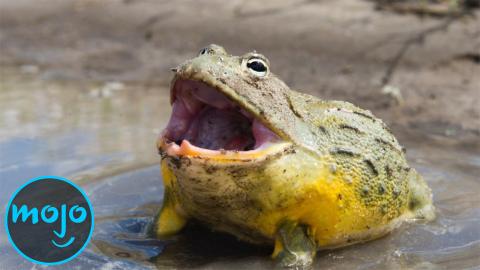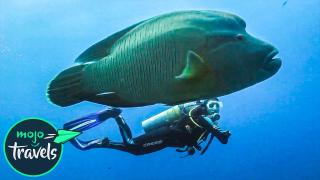Top 10 Weirdest Things Animals Have Evolved to Do

Sometimes in nature, it pays to be a little bit weird. From producing antifreeze, to making infrasonic calls, to using tusks as antennae, these creatures sure do the darndest things. WatchMojo counts down the Top 10 Weirdest Things Animals Have Evolved to Do.
Special thanks to our user David NM for suggesting this idea! Check out the voting page at WatchMojo.comsuggest/top+10+weirdest+animals+in+the+world.
Top 10 Weirdest Things Animals Have Evolved to Do
Top 10 Weirdest Things Caught on Security Footage
Sometimes in nature, it pays to be a little bit weird. Welcome to Watchmojo.com, and today we're counting down our picks for the top 10 weirdest things animals have evolved to do. For this list, we're looking at unusual animal adaptations that allow them to survive against the odds.
#10: Produce Antifreeze
Animals have evolved a range of adaptations to survive extreme cold. Wood frogs, for example, can freeze in winter, remaining frogsicles for months at a time. Antarctic fish have another trick up their fins - manufacturing their own antifreeze. Swimming in waters that often dip below the freezing point of fresh water, the fish produce proteins in the pancreas and stomach that enter their bloodstreams and bind to ice crystals, preventing the crystals from growing. The adaptation allows the icefish to prosper in an environment where few others dare to venture.
#9: Make Infrasonic Calls
Top 10 Holiday Traditions That Make No Sense
The okapi looks like the bizarre lovechild of a giraffe and a zebra. But that’s far from the weirdest thing about it. Not only does it possess scent glands on its feet, and a tongue long enough to groom its own eyes and ears, it also uses low-pitched, infrasonic calls inaudible to the human ear. It’s thought that this allows the animals to communicate at long distances in the dense Congolese forest, without their natural predator, the leopard, overhearing - a talent particularly useful for okapi mothers calling their young.
#8: Use Tusks as Antennae
Top 10 Weirdest Things To Happen In The Olympic Village
The tusk of the elusive “unicorns of the sea” has long defied explanation. Scientists have speculated that the structures - which are really the left canine teeth of the males - serve as icebreakers, or even acoustic probes. But a 2014 study suggests they’re actually giant sensory organs, designed to channel seawater into a sensitive pulp core. This could allow the narwhals to “sense” water conditions, and help them avoid getting trapped beneath new ice sheets. Not everyone agrees, and the tusks might have multiple functions - for example, in attracting lady narwhals . . . because who doesn’t love a good tusk? But if the theory is true, the tusks are basically giant antennae that “feel out” the surrounding environment.
#7: Run on Water
10 Things That Happen If You Only Drink Water
In legend, the basilisk was a fabulous reptile that could kill with a look. Although decidedly less daunting, the real life common basilisk also has a surprising superpower. Living by riverbanks in Central and South America, they’ve evolved a singular method of locomotion: running on water. To flee predators and catch prey, the fleet-footed lizards sprint across streams and ponds for distances of up to 20 feet. Folds of skin between the toes of their hind feet unfurl to slap down on the water, increasing surface area and creating pockets of air. The miraculous ability has earned them a fitting nickname: the “Jesus Lizard”.
#6: Regenerate
Top Scientist Claims Humans Will REGENERATE By 2050 | Unveiled
What’s in a limb? Well, a lot, for most animals. But a special few can shed tails, or even rebuild appendages and organs. The master of this ability is the axolotl, otherwise known as the Mexican walking fish, native to the lakes of Xochimilco, but also a popular pet. Through a process that researchers are still struggling to understand, axolotls can regrow their skin, tail, limbs, and even parts of their spinal cord, all without scarring - a power that some scientists hope to one day harness for humans.
#5: Scuba Dive
Top 10 Most Awesome Scuba Diving Spots Ever
The only spider to live its entire life underwater, this aquatic arachnid is not only a proficient swimmer, but also an artful engineer. In order to wait out prey and avoid predators, the spider has learned to build its own diving bell - weaving a dome-shaped web between water plants that it then fills with oxygen, carried down using fine, water-repellant hairs on its abdomen and legs. The bubbles function as inorganic gills, drawing in oxygen and dispersing carbon dioxide, so that the spider can remain submerged for more than a day without surfacing.
#4: Dehydrate
Tardigrades can survive just about anything - including the vacuum of space. At first glance, the plump and diminutive micro-animals are oddly adorable; but their curved claws hint at a much hardier side. In fact, tardigrades are one of the toughest, most resilient animals on the planet. In hostile conditions they curl up and dehydrate to just three percent of their normal water content, a deathlike state called cryptobiosis that reduces their metabolisms to 0.01% of the normal rate - and they can remain that way for years until their environment improves.
#3: Live Upside Down
Top 10 Craziest Things To Happen to Reporters on Live TV
Also known as the “blue dragon”, the Glaucus Atlanticus has a unique perspective on life. Its top is actually its foot, and its bottom is actually its top . . . The bright blue sea slug spends its life upside down, bobbing about on the ocean’s surface thanks to a gas-filled sac in its stomach. To hide from predators, it’s bright blue on its foot, and silver on its dorsal side - the top that’s on the bottom. It looks cute, but it also packs a nasty sting - feeding on and absorbing the venom of the Portuguese man o’war to produce its own.
#2: Age Backward
Top 10 Weirdest Things Found in Liquor
Paging Benjamin Button . . . We’ve dreamt of immortality for millennia. But only one animal has divined the secret. The immortal jellyfish can age backward when injured, making it, in effect, live forever. The larvae of the Turritopsis dohrnii attach to the seafloor as branched polyps that bud small medusas, which can then revert back to their earlier polyp form, and create a new generation of medusas - all identical clones to the first. It’s a neat survival mechanism that helps them even the odds in a world where plankton make tasty morsels for hungry predators. Before we reveal the identity of our top pick, here are some honorable mentions: Go Fishing (Anglerfish) Survive in Mucus Cocoons for Years Without Rain (African Bullfrogs) Shoot Organs out of Their Bodies (Sea Cucumbers)
#1: Consume Their Own Brain
We’ve all been “hungry enough to eat a horse” . . . but how about hungry enough to eat your own brain? This isn’t the plot of a new zombie movie; for sea squirts, that’s just a natural part of life. Of course, the process is a little more complicated than that, but basically, when the tadpole-like larva finds a good place to settle down, it undergoes a startling metamorphosis - absorbing its own tail, eye, and cerebral vesicle. It then recycles them into organs more suitable for its its new life as a filter feeder on the ocean floor. Hey, whatever works, right?









